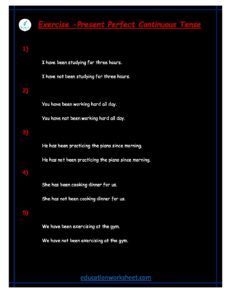changing Present Continuous Tense to negative and positive worksheets
changing Present Continuous Tense to negative and positive
The Present Continuous Tense is a fundamental aspect of English grammar, used to describe actions or situations that are happening at the moment of speaking. In this guide, we will delve into the intricacies of changing the Present Continuous Tense into both negative and positive forms. This comprehensive exploration will equip you with the necessary knowledge to use this tense effectively and accurately.
Positive Form of Present Continuous Tense:
The positive form of the Present Continuous Tense is employed to express actions or events that are occurring at the time of speaking or actions happening around the present moment. It is structured using the following formula:
Subject + am/is/are + present participle (base form of the verb + -ing)
changing Present Continuous Tense to negative and positive
Let’s break down the components of the positive form:
Examples of the negative form of Present Continuous Tense:
- She is not reading a book.
- They are not playing soccer.
- I am not writing an essay.
Contractions in the Negative Form:
In spoken English, contractions are commonly used in negative sentences to make them less formal and more conversational. Here are the contractions for the negative form of Present Continuous Tense:
- I am not → I’m not
- He is not → He isn’t
- She is not → She isn’t
- It is not → It isn’t
- We are not → We aren’t
- You are not → You aren’t
- They are not → They aren’t
changing Present Continuous Tense to negative and positive worksheets

Examples of contractions in the negative form:
- She isn’t reading a book.
- They aren’t playing soccer.
- I’m not writing an essay.
changing Present Continuous Tense to negative and positive worksheets
Interrogative Form of Present Continuous Tense:
In addition to the positive and negative forms, the Present Continuous Tense can also be used in interrogative (question) sentences. To form questions, we invert the subject and the helping verb:
Am/Is/Are + subject + present participle?
Let’s examine the components of the interrogative form:
- Am/Is/Are: The choice of the helping verb is based on the subject.
- Subject: The subject comes after the helping verb in questions.
- Present Participle: The present participle remains unchanged, and it is placed at the end of the sentence.
Examples of the interrogative form of Present Continuous Tense:
- Is she reading a book?
- Are they playing soccer?
- Am I writing an essay?
Negative Interrogative Form:
To create negative interrogative questions, we follow the same structure as interrogative questions but add “not” after the helping verb:
Am/Is/Are + subject + not + present participle?
Examples of the negative interrogative form of Present Continuous Tense:
changing Present Continuous Tense to negative and positive worksheets

- Isn’t she reading a book?
- Aren’t they playing soccer?
- Aren’t I writing an essay?
Common Usage and Examples:
- Everyday Actions:
- Positive: She is cooking dinner right now.
- Negative: She is not cooking dinner right now.
- Interrogative: Is she cooking dinner right now?
- Temporary Situations:
- Positive: They are staying at a hotel this week.
- Negative: They are not staying at a hotel this week.
- Interrogative: Are they staying at a hotel this week?
- Future Plans:
- Positive: We are meeting at the park tomorrow.
- Negative: We are not meeting at the park tomorrow.
- Interrogative: Are we meeting at the park tomorrow?
- Trends and Developments:
- Positive: Prices are increasing steadily.
- Negative: Prices are not increasing steadily.
- Interrogative: Are prices increasing steadily?
changing Present Continuous Tense to negative and positive worksheets
Conclusion:
changing Present Continuous Tense to negative and positive Explore the world of Present Continuous Tense through our engaging worksheets, guiding you to effortlessly transform sentences into both negative and positive structures. Delve into these interactive exercises to hone your grammar prowess, grasp verb conjugation, and construct sentences with precision. Perfect for learners of all levels seeking to master Present Continuous Tense and communicate fluently in English with confidence

